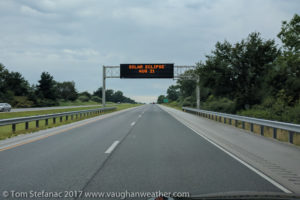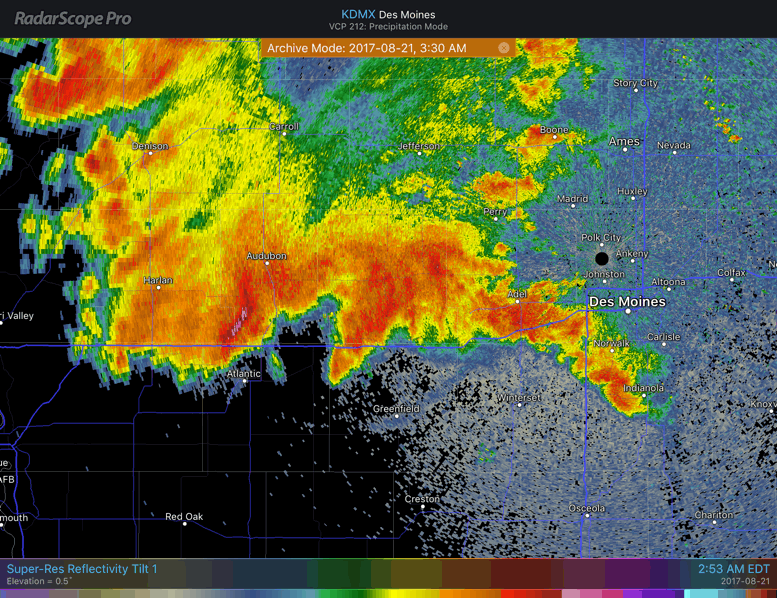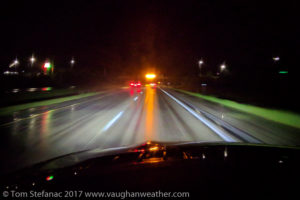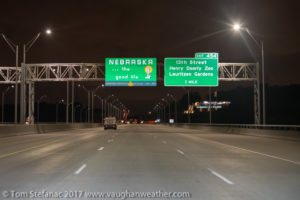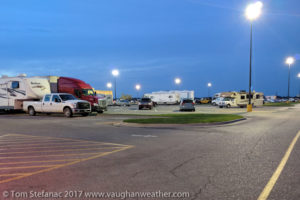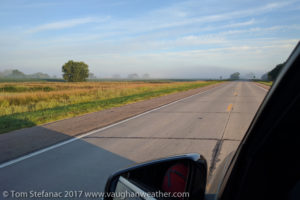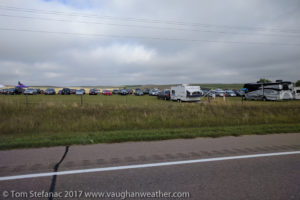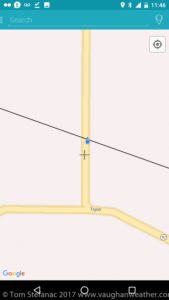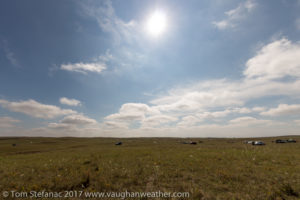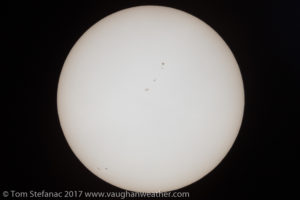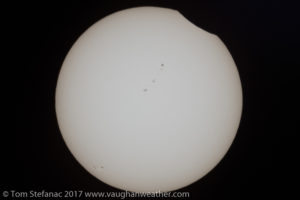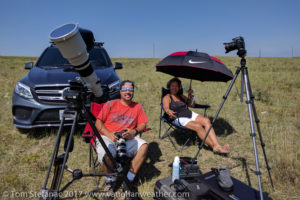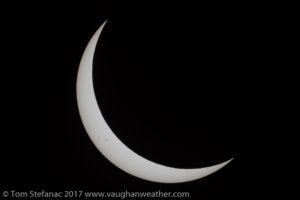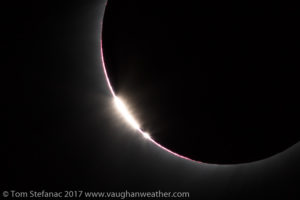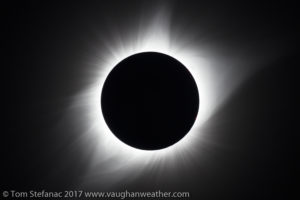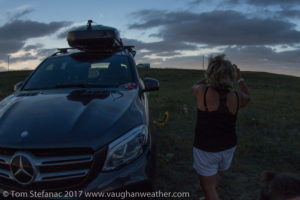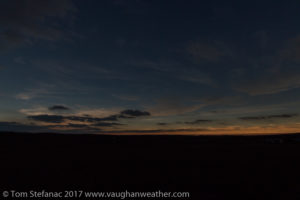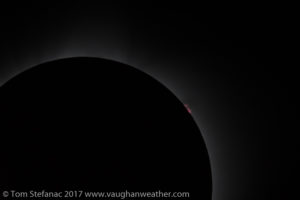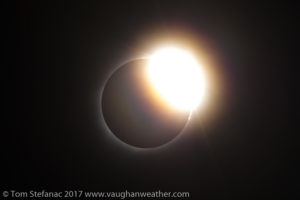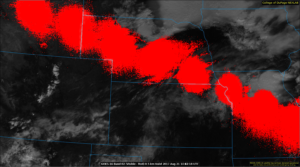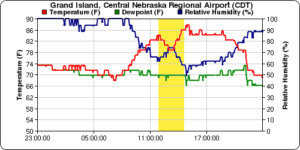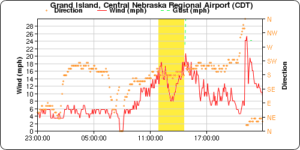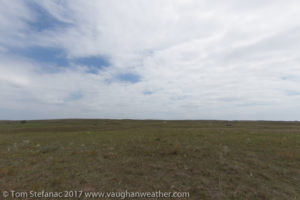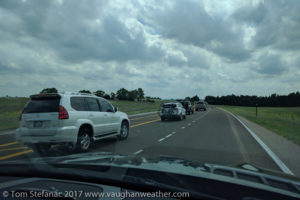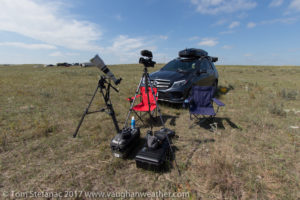Posts Tagged: totality
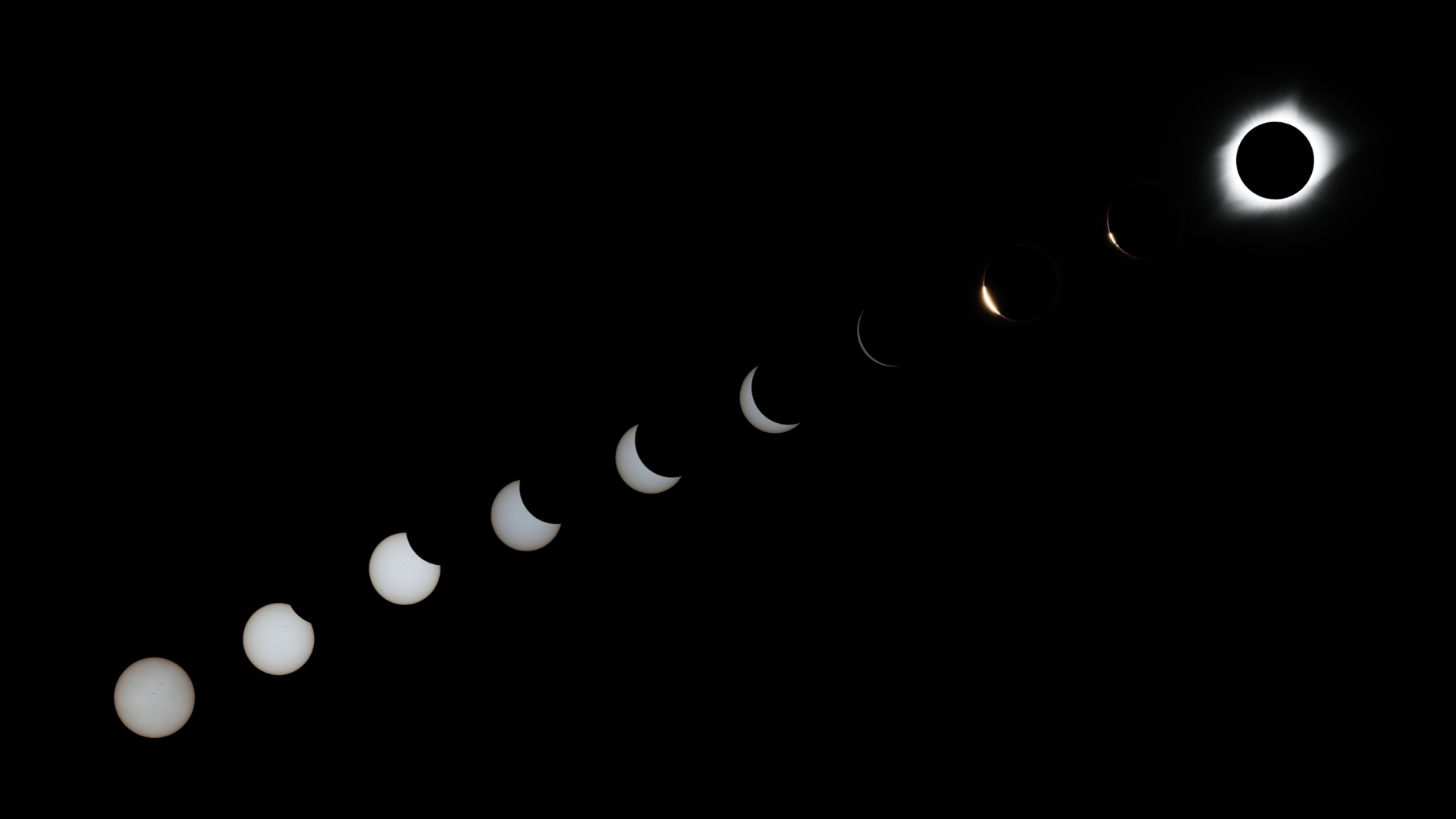
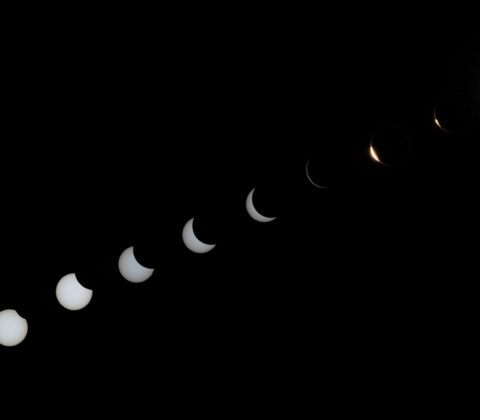
The Great American Eclipse
*** All images in this post and many more are available for purchase through Alamy ***
If you’ve read my previous post titled “Chasing the Great American Eclipse” then you’ll know that I have been planning to chase this eclipse for years! This eclipse really was something special, and lived up to all the hype without the doom that was forecast.
I left my home in Vaughan, Ontario on the morning of Saturday August 19th and made a b-line for the border in Port Huron, Michigan with my fiancee and mom who came along for the trip. I had booked a hotel room prior at the Super 8 in Peru Illinois for that evening. The distance from my home to the motel was about 940 km or a good solid 8 hour drive. I arrived around 11PM that night and had a pretty good sleep.
The following morning I hit the road at 11AM and headed straight for Des Moines, Iowa which is about 400km from Peru. I booked all my hotels roughly a month prior, I paced out the distanced and made sure I gave myself tons of flexibility to work around any cloud cover. I had initially intended to do most of the driving Sunday but figured it was a safe bet to stretch it out over two days instead. I spent the extra cash and booked the Ramada in Des Moines in order to treat myself to some luxury in the form of a nice swimming pool, good room service and half decent in house dining.
I initially intended to hit the road around 5AM targeting Beatrice Nebraska but the weather abruptly changed my plans. Basically there was a zone of instability running right along the path of the eclipse from central Nebraska down into northern Missouri. The risk of thunderstorms was a daunting reality! After a rather stressful couple hours looking at the evening models and data I decided that a 1AM departure would be necessary to head to the clear skies far west closer to the Wyoming border. I theoretically did not have to leave at 1AM but I wanted to give myself a buffer and there was a second problem emerging in the form of a big ugly MCS that was descending on Des Moines and had the potential to slow my commute.
We we’re able to load up the SUV with seconds to spare just as the MCS closed in with gusty winds and blinding rain. It was a pretty grueling drive from that point on, I was basically cutting through storm after storm for about 250 kilometers as everything lined up along the interstate in a big west to east line.
Eventually the skies cleared and the roads dried up just as I was crossing the border into Nebraska. What was a grueling drive suddenly became much more enjoyable! At this point it was 5AM and I was making good progress knocking off the kilometers. The only problem was that I did not have a concrete target. I was looking at real-time obs, infrared satellite data and early runs of the HRRR model to see what my best options were. I decided to head for Grand Island and make a move after that based on the weather observations. The distances involved were huge and while I felt I had plenty of time at the moment, it was just an illusion that would not last long with a mid morning deadline looming. I really wanted to be in position at least thirty minutes before the start of the eclipse to settle in and get all the gear sorted.
We made a quick fuel, food and coffee stop in Grand Island. The hotels were full, the streets were empty and the local Walmart which happened to lay only a few hundred feet off the center line of totality was rammed with campers spending the night while enjoying the luxury of food and fully serviced washrooms.
If you think about it, the Walmart really was a primo spot, no one would bug you, everything you needed was a one minute walk away, they’re open 24 hours and they had good wi-fi coupled with great cell phone coverage.
In retrospect I would have been safe watching the eclipse from Grand Island but at the time my main concern was some wispy high level cirrus pushing north from Colorado. While the cirrus may have been no big deal for most viewing the eclipse, it is absolutely catastrophic if you want good photos. Shooting through cirrus is like shooting through wax paper, you can do it, but everything comes out soft, there’s simply too much diffusion. So rather than risk having high level cloud problems, I decided to continue northwest towards Stapleton.
The drive up to Stapleton was pretty scenic, the sun eventually peaked out above the horizon and thin wispy high level cirrus came into full view. A shallow layer of radiation fog was also burning off rather quickly. I crossed the center line of totality several times along this highway while heading to Stapleton.
Things were great until the radiation fog began to get thicker, and thicker, and thicker. Eventually it was not really burning off and I could see it was increasing in depth. The blue sky above my head shrunk and began to turn into more and more of a milky white colour until it was simply gone. I was concerned but decidedly we pushed on with the northwestward journey. I certainly did not like what I was seeing but every ounce of conviction and instinct in my body told me not to worry, in the back of my mind I knew that it would burn off.
Eventually at about 9AM and 30 kilometers outside of Stapleton in the hilly terrain the fog began to break-up. I can’t tell you how relieved I was to see that, and to my surprise, the high level cirrus was all but completely gone. Unfortunately, my cell service had also vanished with the fog and clouds. I could make and receive calls but the internet data was running at a snails pace.
Suddenly, the weather observations I had been relying on were totally unavailable to me! Further frustrating was that as the fog burnt off, the clear sky was suddenly slowly being populated by stratus and stratocumulus. Again, I knew in the back of my mind mind that eventually this cloud too would burn off as vertical mixing increased but as with all weather, there’s never a guarantee that it’ll run on schedule and by this point it was already 9:30 AM and time was running out.
With no real data, I had to eyeball and “feel out” my odds, so I decided it was best and safest to continue pushing northwest towards the next town on the map known as Tryon. I actually had to do a double take, I kept reading Tryon but I wanted to say “Tyrone”. The rather thick strotocumulus slowly gave way to clearer patches and eventually the clouds began to turn into puffy fair weather cumulus. This was a great sign, but I could still feel the stickiness in the air, it was very very humid and ideally, drier is far better for less cloud and any potential fog.
I finally arrived in Tryon around 10:30 AM and began to hastily look for a parking spot. I edged my way to north side of town and found a farmer offering parking in his field, jackpot! I drove through and parked right on the eclipse centre line. I was right where I wanted to be with sunny skies and no real risk of cloud cover from any level.
Once parked I quickly began to unload the car and get my gear in order. I wanted to grab some photos of the sun before the eclipse and then capture the progression of the eclipse sequentially.
Probably 15 minutes after parking (around 11AM) some weak cumulus began to bubble up directly over my head. It was a little concerning since one poorly placed cloud is all that’s needed to ruin the adventure. I kept staring at the sky between getting setup and more cumulus began to bubble up above my head. I was sort of dismayed at this point since the sky above should have been totally clear, but my guess is that the residual moisture was so high in the boundary layer it was just coming back as cloud. There was little in the way of wind so the thermal heating was allowing the cloud to form right above me. At this point the eclipse was now probably 10 minutes away from starting and I was extremely concerned but then I had sudden relief. Clearing in the sky opened up to the north and the clouds were slowly drifting south. Eventually the clearing pushed in and the cumulus which was now beginning to dissipate moved south and away from the sun.
So once again I was relieved, the sky was clear and I hastily continued to setup my gear. The field I had chosen to park in (with a small fee paid to the rancher) began to steadily fill with vehicles. It was nice in a way since while I wanted to be free of distraction still having other people around (albeit at a distance) added to the feel of the atmosphere, it created a bit of a stadium feel, everyone was there for a spectacle of nature that was going to unfold.
I snapped this photo of the sun at 11:17 AM, just 13 minutes before the start of the eclipse. I took it in the process of tuning the camera settings. It was weird looking at the sun, on the one had the day looked like any other day, there was nothing strange about it. There was no hint of the moon in the sky and sun looked like it always does.
I could not imagine that in a few minutes the moon would slowly begin to obscure it. It’s a hard feeling to explain, there’s nothing to indicate that anything you’ve been told is correct and while the math might add up there’s nothing within view to cumulatively show that math adding up.
I kept checking the time on my watch and using an application on my phone which calculates the eclipse event times using GPS data. It kept showing the start of the eclipse was getting closer and closer yet the sun and day felt so normal. As crazy as it sounds, I had this moment of doubt, I thought to myself “man, I really hope everyone is right and there’s going to be an eclipse today”. I know it sounds insane, but that thought really crossed my mind.
I kept looking at the sun through my protective glasses thinking to myself “I don’t believe this is going to happen”. I’m not a pessimist or anything and I understand math, science an how it plays into astronomy but being so use to weather where there is never any certainty, I was mistakenly subconsciously applying that same lens and frame of thought to a totally different process. Celestial bodies are in motion, we know their motion, it’s relatively easily predictable and there’s nothing to cause deviation. Whereas when I look at the weather, we simply have far less information, there’s far less certainty, much more going on and sometimes that thunderstorms I chase and forecast don’t blow up from clear skies.
I looked at my eclipse application again and the count down to the start of the eclipse read 3 seconds, 2 seconds, 1 second, zero…., the eclipse was starting. I quickly snapped a photo and dawned my eclipse glasses and there it was, the sun had a small sliver missing from the top right corner. The eclipse was actually happening and right on schedule. Up until this point it had all been theoretical, everything was a prediction, nothing was tangible. I had driven 2400 km on pure speculation and theory. I don’t know why it was so amazing to me that it was actually happening but suddenly the anxiety of possible failure seemed to fade away. I was actually relaxed and breathed a huge sigh of relief!
The hour and 23 minutes leading up to totality felt very long and truth be told, totality was what all the buzz was about, the partial obscuration was cool but I had seen it before. I wanted the main show to begin but you can’t rush nature. I filled the time by taking photos of the slow progression of the moon obscuring the sun, the sky slowly darkening, family group photos and generic things. I also took time to tinker with my GoPro and video camera. My camera shy fiancee opted not to be in any photos on this website sadly.
While watching the eclipse it was a scorcher! The sun was just beating down and I felt like I was melting. My mom (holding the umbrella) felt the same way, but at least she was able to get some shade. The scorching heat did not last very long though, about half way to totality the sun began to visibly wane in the sky and the day suddenly did not seem as bright as it was before.
As time progressed and more of the sun disappeared behind the moon the air began to feel slightly cooler. The air temperature itself at this point had not leveled out but what was occurring was more of a sensory perception illusion. The human body detects visible light, near infrared, UV radiation and long wave infrared (thermal infrared) as heat. That’s why standing out in the sun feels substantially hotter than standing in the shade even though there may not be any substantial change in your body temperature. Thus with the suns diminishing intensity, the body naturally has less light to interpret as heat and you feel cooler despite the air temperature remaining constant or even increasing.
At about 10 minutes from totality, the day still seemed pretty normal. Nothing odd was happening, except that the sun was visibly dimmer, but no dimmer than it would be with a moderate layer of cirrus diffusing the daylight. The nearby farm animals were acting normal, the cows were just grazing and going about their business, birds and insects were flying around and the eclipse gazing dogs were simply going about their business seemingly unaware of what was coming.
Things began to get interesting about 5 minutes away from totality, the daylight began to visibly fade rapidly and a sudden chill could be felt in the air, there was so little sunlight that the air itself began to cool quite rapidly dropping closer to the dew point and bringing the relative humidity right up. I could feel my hands and everything getting sticky in the growing humidity. The birds and large insects (dragonflies / butterflies) that were buzzing around earlier began to slowly vanish. The sky was also becoming eerie, it was growing darker but the sun still appeared very bright to the naked eye. It was an odd feeling but very much expected from my past experience with partial eclipses and literature I had read, but this however was on a much grander scale.
Suddenly everything changed just one minute away from the start of totality! A late evening darkness began to envelop the landscape and the sun now fading rapidly cast a glow that was about as strong as bright moonlight. I was busy getting ready for baileys beads, but I took a moment to look at the northwestern horizon and was amazed to see a huge zone of darkness rapidly expanding and seemingly growing in height consuming the horizon. It was the moons inner shadow (the umbra) approaching at a cool 2500 kph (1535 mph). I wish I had taken a second to photograph it but that thought at the time did not cross my mind. Suddenly, the dogs that were eclipse watching broke out barking like crazy, they finally realized something was not right. The cows nearby remained completely silent and motionless. By this point the air was now very cool, to the point where you almost needed a sweater and very sticky from the climbing humidity..
The clouds which had disappeared were also now starting to reappear in pockets! The reverse effect was occurring, while the sun heated and mixed the air to burn them off, the air was now cooling and the mixing had stopped essentially reversing the processing. Fortunately one stray cloud quickly passed without obstructing my view and the sky remained clear just as totality was about to set in. There was so much happening in such little time, I was changing camera settings and getting ready to blast off photos while above the stars one by one began to become visible, but totality was still not upon my location.
Even though about 99.5% of the sun was blocked, the last remaining rays that produce the diamond ring effect and baileys beads were so bright they still wholly overwhelmed the camera until totality was 10 seconds away. Then, and only then did the shimmering beads appear across the lunar limb and quickly fade one by one into darkness. At this point I was just blindly taking photos and full out staring at the sun with my eyes. It was just absolutely amazing!
As the last shimmering point of light vanished, darkness overtook the land! Then, the silence was broken by cheering and clapping, only to be outdone by the sound of a roaring jet engine as NASA scientists chased the eclipse from a WB-57 aircraft. It was incredible, words simply cannot describe the feeling in that moment, the surrealism of what was occurring, day had turned to night in a instant, there was twilight on the horizon, dogs were losing their minds, people were clapping, cheering and a jet engine could be heard roaring past on the edge of the umbra. It was just surreal!
The suns corona which was slowly becoming visible was now fully revealed! Red prominence’s could be see bending, twisting and blasting off into space, the orange-reddish glow of the suns chromosphere was brightly visible and the fine detail in the corona was visible giving it a wispy, wiry type appearance.
As I watched the corona, it’s subtle motion was revealed with a little bit of elasticity as as the suns gravity and varying magnetic charges played upon it. I would say it moved about as quickly as a vibrant aurora, but was far easier to observe with much more detail.
I did take a moment to take everything in, I did not want to experience the eclipse through the lens of a camera, I actually wanted to enjoy it as a tourist or the average Joe.
Looking around, I found the strange 360 degree evening sky to be somewhat fascinating and odd. It was basically like the sun was setting in every direction, or I guess contextually, no specific direction. I took a longer exposure of my mom looking at it and trying to get a photo on her phone. It was very dark, you basically needed a flashlight to see fine details, it was very much like night. The photo on the right contextually is more true to life as far as brightness goes but even so it’s still probably 1-2 stops brighter than it actually was. During totality the sky overhead was very dark, with virtually nothing other than the sun and stars visible.
This complete twilight horizon was going to be a short lived affair, as the moons shadow kept moving east, the western horizon began to grow bright and brighter signalling the approaching end of totality. With this in mind I made sure to take a variety of solar photos, one of the features that was quite rare and is not well shown in photographs are the suns prominences.
The prominences also known as filaments are basically charged strings of helium and hydrogen plasma that twist out along magnetic loops. They’re predominately anchored to the suns surface but can reach thousands of kilometers out into space. During the eclipse, several were visible around the edge of the sun appearing as a reddish pink colour in the visible light spectrum.
Photographing these microscopic features when compared to everything else requires a crisp aperture, ideally F8 to about F13, and and a relative fast shutter to beat down the light from the fainter corona blowing them out. Unfortunately there’s really no way to capture all the elements of an eclipse in a single photo due to the great variation in light intensity across different portions of the event.
Like all good things, even an eclipse must eventually end and time was running out, totality at my location had a mere duration of 2 minutes and 40 seconds. The west horizon in the span of about 10 seconds suddenly became very bright and edge of the moons umbra was fast approaching, totality was about to end. Then the first shimmers of bright sunshine made their way across the moons mountain to once again reveal baileys beads and the diamond ring effect.
I snapped off dozens of photos, I was certainly trigger happy but more so because the baileys beads event occurs so quickly and there is a huge difference between how the beads look every half second. It’s much like sports photography at a fast paced game, an image will change significantly in the span of just a couple seconds and baileys beads with any eclipse is no different.
Before I knew it, the eclipse had ended and the moon was moving away from the sun, daylight was returning and it was gradually getting brighter by the second. I had made a mental note somewhere amidst my eclipse planning to make sure that I saved data from the news GOES 16 satellite. The satellite is an amazing piece of technology capable of beaming back images of the earth as frequently as every minute.
The new rapid update imagery with increased resolution gave a remarkable view of the moons shadow as it passed across the landscape. The satellite sees total darkness or near total darkness as white. Part of this is spectrum folding within the decoding software, but it gives a great idea of where total or near total darkness fell. What a year to have had the launch of this new powerful weather observation satellite.
As the eclipse slowly ended, the fellow eclipse watchers which had been parked in the field around me proceeded to leave, some rather quickly after totality had ended. A few die hard fans like myself stuck around to the very end, but truth be told there was not really a rush. There were literally tens of thousands of people rushing out to jam up the roads. Unlike a movie theater, sporting event or concert where everyone is coming from the same source, this was more like rush hour traffic where hundreds of people were coming out of different office buildings all along the route. There really was no beating the traffic.
What I found meteorologically interesting was the extent to which the eclipse had killed a nearby developing cumulus fields and induced a stratocumulus field. Despite the relatively short duration of the event, with the solar input dropping from a few thousands watts to nothing it’s easy to understand how significantly even this short duration can effect the larger weather pictures, at least for a time before the atmosphere recovers and convection resumes.
With the loss of daytime heating the wind fields also diminished substantially as the air calmed down and convective mixing slowed to crawl. There was no weather station in Tryon, but KGRE in Grand Island which also experienced totality had very similar weather conditions. You can see how the relative humidity approached 75% during totality with the air cooling from a pre-eclipse high of 30C / 86F down to a low of 21C / 71F just as totality was ending.
I was surprised at the extent of local cloud cover after the eclipse. Part of the cloud was a product of an impending MCS collapsing south from the north, but the majority of it was well ahead of the MCS and the result of boundary layer and low level saturation none of them
There were some clouds during totality but fortunately they stayed away from my field of view, so I really did dodge a couple bullets and luck did play a role.
Once the eclipse had fully ended we packed up and hit the road. Traffic was initially light, then gradually became heavier and heavier. Once we approached North Platte, Nebraska everything seemed to grind to a halt. This was an area where there were no alternative routes due to the local geography of a nearby river. So in that regard, jumping on a dirt back road was not an option, the only option was to tough it out with everyone else and try to make the best of a slow drive.
The town of North Platte itself was a zoo. There were lines for everything, the bathroom, fuel, food and anything else imaginable. I took two diesel jerry can with me which I filled up before leaving for the trip and fueled up in Grand Island earlier in the day. Between the superior range of diesel fuel, my near full fuel tank and two reserve cans we did not need to stop for fuel. A reassuring observation I noted was that the truck fueling stations were pretty desolate, so if I had to I could have just pulled up to a transport truck card lock and filled up. I have a truck fuel nozzle to vehicle grade nozzle adapter for just such an occasion.
We passed a couple of broken down vehicles and a few vehicles which looked to have run out of fuel while idling. I was critical to note that some peoples idea of an emergency fuel can was a little 5L / 1.5 gal container you’d use to fill up a push mower. In perspective if you’re getting 8L/100km on the freeway, in bumper to bumper traffic your getting something like 15 – 20L/100k or maybe even less. So even with amazing fuel economy you’ll still only get 60-70 km on that little tank and realistically maybe 15-20 km in bumper to bumper traffic. In rural Nebraska it’s not uncommon to drive 100 km or more without ever seeing a fuel station.
My logic was simple, driving a diesel vehicle and having 40L of reserve fuel plus a full 93L fuel tank would give me 133L total, enough to travel 1600 kilometers at 8L/100km realistically or 665 km at 20L/100km if I was getting abhorrent fuel mileage in stop and go traffic. That’s enough range to basically leave the state if need be and certainly enough to find somewhere to fill up. It also gave me the option to drive potentially hundreds of kilometers off-road if the apocalypse started.
Fortunately traffic thinned out south of North Platte and the interstate was moving very well. I had booked a room in Omaha at the local Microtel for the night to shorten the following days drive to the airport in Sioux City, Iowa where my mom would be flying out to connect in Chicago before arriving in Toronto. As luck would have it, we were blasted by the MCS (visible in the satellite loop above) late that evening while leaving the Texas Roadhouse restaurant near the hotel. Seeing as I had driven most of the night, my mom drove most of the time after the eclipse, although she had serious problems following the GPS nav commands. Thankfully my fiancee Jen kept her on track while I drifted in and out of consciousness in the backseat.
All in all the eclipse trip went out without a hitch and I never had to ditch any hotel reservations, all the planning was enough without any real over planning. The following day (August 22nd) I dropped my mom at the airport and my fiancee and I headed to back west across South Dakota to visit the Badlands near Wall and eventually the Black Hills and the Keystone Area.
Here is a short video showing the moments leading up to totality and it finally occurring.
